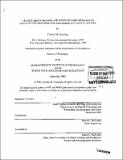| dc.contributor.advisor | Daniel C. McCorkle. | en_US |
| dc.contributor.author | Gramling, Carolyn M | en_US |
| dc.contributor.other | Woods Hole Oceanographic Institution. | en_US |
| dc.coverage.spatial | n-us-nc | en_US |
| dc.date.accessioned | 2012-03-16T16:01:52Z | |
| dc.date.available | 2012-03-16T16:01:52Z | |
| dc.date.copyright | 2003 | en_US |
| dc.date.issued | 2003 | en_US |
| dc.identifier.uri | http://hdl.handle.net/1721.1/69769 | |
| dc.description | Thesis (Ph. D.)--Joint Program in Marine Geology and Geophysics (Massachusetts Institute of Technology, Dept. of Earth, Atmospheric, and Planetary Sciences; and the Woods Hole Oceanographic Institution), September 2003. | en_US |
| dc.description | Includes bibliographical references. | en_US |
| dc.description.abstract | Groundwater discharge into estuaries and the coastal ocean is an important mechanism for the transport of dissolved chemical species to coastal waters. Because many dissolved species are present in groundwater in concentrations that are orders of magnitude higher than typical river concentrations, groundwater-borne nutrients and pollutants can have a substantial impact on the chemistry and biology of estuaries and the coastal ocean. However, direct fluxes of groundwater into the coastal ocean (submarine groundwater discharge, or SGD) can be difficult to quantify. Geochemical tracers of groundwater discharge can reflect the cumulative SGD flux from numerous small, widely dispersed, and perhaps ephemeral sources such as springs, seeps, and diffuse discharge. The natural radiocarbon content (A14C) of dissolved inorganic carbon (DIC) was developed as a tracer of fresh, terrestrially driven fluxes from confined aquifers. This A14C method was tested during five sampling periods from November 1999 to April 2002 in two small estuaries in southeastern North Carolina. In coastal North Carolina, fresh water artesian discharge is characterized by a low A14C signature acquired from the carbonate aquifer rock. Mixing models were used to evaluate the inputs from potential sources of DIC-A'4C to each estuary, including seawater, springs, fresh water stream inputs, and salt marsh respiration DIC additions. These calculations showed that artesian discharge dominated the total fresh water input to these estuaries during nearly all sampling periods. | en_US |
| dc.description.abstract | (cont.) These new A14C-based SGD estimates were compared with groundwater flux estimates derived from radium isotopes and from radon-222. It is clear that these tracers reflect different components of the total SGD. The fluxes of low-A14C and of 222Rn were dominated by artesian discharge. Estuarine 226Ra showed strong artesian influence, but also reflected the salt water SGD processes that controlled the other three radium isotopes. The flux of 228Ra seemed to reflect seepage from the terrestrial surficial aquifer as well as salt water recirculation through estuarine sediments. The fluxes of 224Ra and 223Ra were dominated by salt water recirculation through salt marsh sediments. This multi-tracer approach provides a comprehensive assessment of the various components contributing to the total SGD. | en_US |
| dc.description.statementofresponsibility | by Carolyn M. Gramling. | en_US |
| dc.format.extent | 2 v. (347 leaves) | en_US |
| dc.language.iso | eng | en_US |
| dc.publisher | Massachusetts Institute of Technology | en_US |
| dc.rights | M.I.T. theses are protected by
copyright. They may be viewed from this source for any purpose, but
reproduction or distribution in any format is prohibited without written
permission. See provided URL for inquiries about permission. | en_US |
| dc.rights.uri | http://dspace.mit.edu/handle/1721.1/7582 | en_US |
| dc.subject | Joint Program in Marine Geology and Geophysics. | en_US |
| dc.subject | Earth, Atmospheric, and Planetary Sciences. | en_US |
| dc.subject | Woods Hole Oceanographic Institution. | en_US |
| dc.subject.lcsh | Ocean outfalls Environmental aspects North Carolina | en_US |
| dc.subject.lcsh | Groundwater Sampling North Carolina | en_US |
| dc.subject.lcsh | Groundwater tracers | en_US |
| dc.subject.lcsh | Radioactive tracers in marine biology | en_US |
| dc.subject.lcsh | Radioactive tracers in oceanography | en_US |
| dc.subject.lcsh | Groundwater ecology North Carolina Methodology | en_US |
| dc.subject.lcsh | Estuarine ecology North Carolina Methodology | en_US |
| dc.subject.lcsh | Coastal ecology North Carolina Methodology | en_US |
| dc.title | A radiocarbon method and multi-tracer approach to quantifying groundwater discharge to coastal waters | en_US |
| dc.type | Thesis | en_US |
| dc.description.degree | Ph.D. | en_US |
| dc.contributor.department | Joint Program in Marine Geology and Geophysics | en_US |
| dc.contributor.department | Woods Hole Oceanographic Institution | en_US |
| dc.contributor.department | Massachusetts Institute of Technology. Department of Earth, Atmospheric, and Planetary Sciences | |
| dc.identifier.oclc | 55873358 | en_US |
